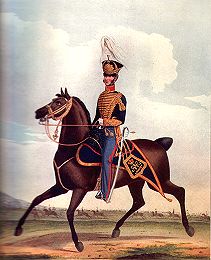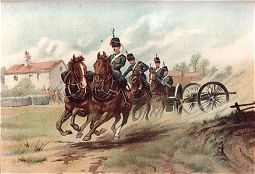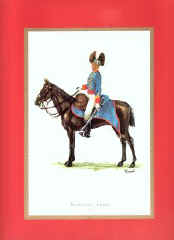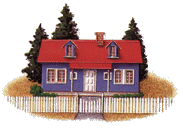|
WEAVING was one of the largest |
|
Henry Airth
~ ROYAL HORSE ARTILLERY ~
|
WEAVING was one of the largest |
|
Like his father Adam, young Henry was a weaver prior to his enlistment
in the ROYAL HORSE ARTILLERY
which took place on March 10th 1803 at the age of 16.
He was a Boy Soldier for 2 years (1803-1805)
a Private for 4 years and 100 days (1805-1807)
a Corporal for 4 years (1809-1813)
and a Sergeant for 3 years (1813-1816)
|
|
|
~ Henry was sent to Europe during the Napoleonic Wars ~
As a cavalryman in the Royal Artillery Drivers
in the Peninsular War
in Belgium and Spain,
it is said he 'served with distinction under Wellington'.
 |
Painting of an Officer in Royal Horse Artillery - Horse Brigade - Belgium 1815
[artists were L Mansion & St Eschauzier]
He also served in the Royal Artillery Drivers
at the BATTLE of WATERLOO on June 18 1815,
also under Wellesley, later the Duke of Wellington.
During the Battle of Waterloo, he had 2 horses shot from under him !!
* *
BATTLE of WATERLOO, 18 June 1815:
For a 1st hand description,
See The Royal Horse Artillery Repulse Enemy Cavalry, late afternoon.
by Field Captain A C Mercer, Royal Horse Artillery.
 |
Through the driving rain, Captain Mercer (G, troop Royal Horse Artillery),
riding his charger Cossack,
leads his battery
to the ridge of Mount Saint Jean on the eve of the Battle of Waterloo.
[painting by Chris GILES]
* *
Brief History of ROYAL ARTILLERY (basically quoted from source)
It could be said that the history of the Royal Artillery
extends back to an incident which occurred during the Battle of Crecy,
when a French foot soldier was killed by a British cannon
and there have been gunners serving in British armies since then.
However, it wasn't until 1485 that the first official gunners were appointed,
as part of what became the Board of Ordnance.
Throughout the next 400 years the forts around Britain
had master gunners permanently appointed by the Board of Ordnance.
Trains of artillery were formed for campaigning both at home and abroad,
with guns and the men to serve them.
1716 to 1800
In 1716, under a Royal Warrant,
two companies of artillery, each of 100 men,
were formed at the Woolwich Warren (later the Royal Arsenal)
to ensure that a regular force of gunners was available when needed.
Woolwich has been the spiritual home of the 'Gunners' ever since that time,
although the Regiment had moved to its famous barracks on Woolwich Common by 1805.
The Regiment expanded rapidly in the 18th century
and saw service in every campaign and every garrison orld-wide.
In 1793, the Royal Horse Artillery was formed
to provide greater mobility in the field,
and soon became associated with the role of supporting cavalry.
The Royal Horse Artillery performed so well
that it became a corps d'elite within the Regiment.
The 19th CENTURY
During the early part of the Peninsular War
the Royal Artillery were very light on the ground.
For example, in May 1808,
the artillery support for the British army and the Kings German Legion
consisted of 3 batteries (6 guns each battery) of light 6-pdrs
and three batteries of 3-pdrs.
The 3pdrs were considered to be of very limited hitting power.
By June 1813, during the Vittoria campaign,
the strength had been increased to 7 batteries of 9-pdrs,
2 of heavy 6-pdrs and 4 of light 6-pdrs.
It was only by the Waterloo campaign
that all the Royal Artillery foot brigades
were equipped with five 9-pdrs and one 5-in howitzer.
Other ordnance used by the Royal Artillery
were a mountain battery formed for the crossing of the Pyrenees.
They were equipped with six 3-pdrs,
which were broken down and carried on the backs of mules,
and were crewed by a mixture of British and Portuguese gunners.
* *
The Battle of Waterloo was fought on a Sunday, the 18th June 1815
and was the culmination of a short campaign
that began in the early hours of the Thursday before.
The regiments engaged at the Battle are well
documented and a list of them follows.
In terms of the manpower employed,
the Battle of Waterloo was a very small affair
when compared with the Peninsular War or the Anglo-American War.
At about this time the British Government began to issue medals
to soldiers for the campaigns in which they fought.
The Waterloo Medal was the first of these.
In the main, these early medals included the name of the soldier
and were provided by the Royal Mint.
In many cases the original medal lists still survive.
The Military General Service Medal,
which was awarded to soldiers who fought in the Napoleonic Wars 1805 to 1814,
wasn’t in fact issued until 1847,
by which time of course, many of the men entitled to it were already dead.
[does anyone know if Sgt Henry ever received such medals?]
~ THE BATTLE OF WATERLOO ~
Regiments which fought at the Battle, in order of precedence:
(1) Guards Cavalry
(2) Line Cavalry
(3) Guards Infantry
(4) Line Infantry
(5) Ancillary Corps
ROYAL Regiment of ARTILLERY
Foot Artillery / Royal Horse Artillery / Royal Corps of Artillery Drivers
* *
The Royal Horse Artillery (part of the Royal Artillery) was raised in 1793.
·
The Regiment does not display Battle Honours,
although during Ceremony the Guns are given the same honour as standards.
Many batteries are awarded honour titles ,
which commemorate actions which the Battery concerned played a major role.
 |
The Royal Horse Artillery - Painting by Malcolm Greensmith
* * *
During this time, the rank of sergeant carried more prestige
and greater authority than now,
and the pay was considered quite good.
|
|
Sgt Henry's discharge from the Royal Artillery Drivers on April 9 1816
came as a result of a reduction in British forces after the Napoleonic Wars.
He received a pension of 5 pence per day as of April 10 1816,
and lived in Rutherglen as a hosier for a number of years.
| Description of Henry on discharge papers 29 years and 100 days old, 5 feet 10 inches tall, with black hair, gray eyes and a swarthy complexion.... |
SGT Henry served for some years in the Ordnance Department in Rutherglen,
later known as the War Office.
* *
Henry & Marion and family emigrated to Canada in 1827
with £40 in their pockets and a real pioneer spirit.
They first settled in Goshen,
but Henry soon discovered that as a former sergeant in the Royal Horse Artillery
he was entitled to a 200 acre government grant.
They left McNab Township and moved to Horton in January 1829.
[Info gleaned from Copy of Extract of Discharge Document as well as Internet Sources]
Return to Sgt Henry AIRTH, Esquire
